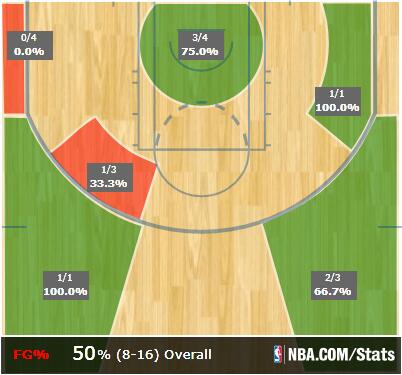3 ways the Pacers can counter the Heat's small-ball tactic
The Indiana Pacers looked utterly dominant at the start of Game 3.
In the first half, the Pacers defense smothered Miami's attack, and led by as much as 15 points. However, their defense unravelled in the second half, allowing Miami to capture the pivotal victory.
What changed? Simple: the Miami Heat shifted to a small-ball lineup.
Heat coach Erik Spoelstra settled on a five-man unit consisting of the "Big 3", along with a pair of shooters in Norris Cole and Ray Allen in the fourth quarter. In eight minutes of play, they outscored the Pacers' starters by a total of 20-5.
Miami's small-ball lineup was successful for several reasons. First, it gave the Heat a substantial quickness advantage. Second, it created awkward match-up problems for the Pacers. Finally, the wealth of three-point shooting forced Indiana into having to cover vast swaths of space on defense.
However, although Miami's small-ball squad is admittedly formidable, it's not invincible. Here are three adjustments that the Pacers' starters can make to overcome Miami's strategy.
Put David West on LeBron James
Pacers forward David West is smart, savvy, and a pick-and-pop machine. He was vital to Indiana's first two playoff series victories and if the Pacers are to successfully topple the Heat, he will need to be on the floor.
Having said that, West should never be the primary defender against Heat guard Ray Allen. In Game 3, West found himself chasing Allen through a maze of screens, which afforded Allen a wealth of space to sink all four of his three-point attempts in the fourth quarter.
The mismatch was painfully obvious, but Pacers head coach Frank Vogel stuck with the strategy in order to slot forward Paul George on Heat forward LeBron James. However, as demonstrated in Game 3, the situation is untenable, and the two Pacers need to switch assignments.
Pitting West against James concedes quickness, but they are fairly similar in size, and West's strength should allow him to keep James out of the paint.
Attack the post
The Heat's small-ball lineup conceded size for an edge in quickness. However, unlike Miami, the Pacers failed to capitalize on their advantage. As seen in the shot chart below, only four of their 16 field goal attempts in the quarter were launched from within the paint.

The Heat's interior defense consisted of the duo of James and forward Chris Bosh. Both players are good defenders, but Indiana's front-court of West and center Roy Hibbert hold a substantial size advantage. They should be able to capitalize by way of posting up, and attacking the glass. Instead, they combined for just four attempts in 14 total minutes of play in the fourth quarter.
More importantly, the Heat's thin frontline should be an open invitation to guards like Lance Stephenson and George Hill to attack the basket at will. Even if Bosh rotates over for a shot contest, Hibbert should be able to scoop up the rebound for an easy put-back.
Never leave Ray Allen
Allen holds the NBA record for most three-point field goals made. Even at the ripe old age of 38. Allen is still deadly from deep, as demonstrated by his 13-point fourth quarter in Game 3.
As mentioned earlier, part of Allen's success was attributable to him having a quickness advantage over West, but he was also the beneficiary of some lackadaisical defense on the part of the Pacers.
Two of Allen's three-pointers in the fourth quarter came in transition. The Pacers need to do a better job of locating Allen, and sticking a body on him. Another triple arose because Stephenson was busy ball-watching, rather than hawking Allen. It's a thankless task, but whomever is responsible for checking Allen needs to be diligent.